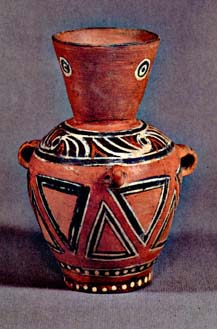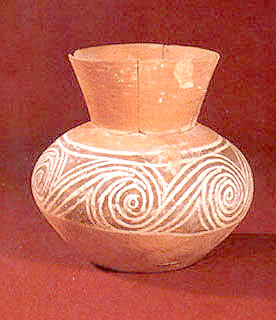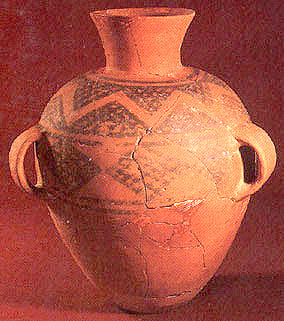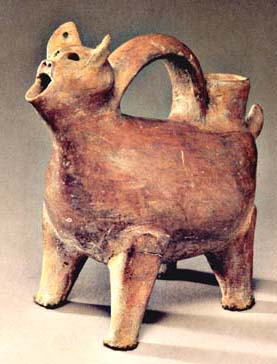|
Below are four of the 94 pieces of
pottery from this tomb. Pottery found in Dawenkou tombs varied
greatly in shape and size. Keep the shapes of these pottery pieces
in mind when you look at later bronzes. |
|
 Much
of Neolithic pottery is decorated with geometric designs. Although
these designs appear purely abstract, some of them may be derived from
forms in nature. Much
of Neolithic pottery is decorated with geometric designs. Although
these designs appear purely abstract, some of them may be derived from
forms in nature.
Can you imagine what kinds of
organic forms might have inspired the decoration on this vessel?
How does the decoration and color scheme complement the shape of the
pottery?
| SOME THOUGHTS:
Some have speculated that the triangles might have evolved from
the shape of fish fins and fish tails. The circular forms
may be inspired by eyes. |
How do you think this pottery was
made?
| ANSWER: This piece
was probably made on a wheel, in contrast to earlier handmade
pottery. Invention of the pottery wheel, first used
shortly after 3000 B.C. by the Dawenkou and Longshan cultures,
meant that potters could make thin-walled, evenly formed vessels
with greater speed. |
|
|
Height:
17.2cm
| SOURCE:
Zhonguo zhongda
kaogu faxian
(Beijing: Wenwu chubanshe, 1990), p. 55. |
|
|
Below are two more pots from this
tomb: |
|
 
|
|
Height: 13.4cm
| SOURCE:
Zhonguo zhongda kaogu faxian
(Beijing: Wenwu chubanshe, 1990), p. 56. |
|
Height: 28.3cm
| SOURCE:
Zhongguo meishu quanji v. 1 (Beijing: Renmin meishu
chubanshe, 1988), p. 14. |
|
|
What animal is the
piece below meant
to represent? What was the significance of this animal?
|
HINT: Think about
some of the animal parts that are found in Tomb 10.
|
|
|

|

|
|
Ceramic
vessel Height: 22cm Length: 25cm
| SOURCE:
Zhongguo meishu
quanji v. 1 (Beijing: Renmin meishu chubanshe, 1988), p. 14. |
|
Detail
|
SOURCE:
Zhongguo meishu
quanji v. 1 (Beijing: Renmin meishu chubanshe, 1988), p. 14. |
|
| ANSWER:
Probably a pig, a staple of the Neolithic economy. The
Dawenkou people cultivated millet and domesticated pigs and
other livestock. Heads and jaws of pigs were frequently
buried with the dead as symbols of wealth. |
|

